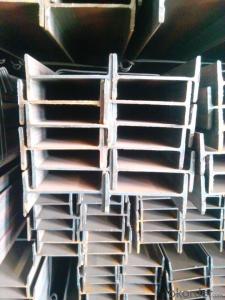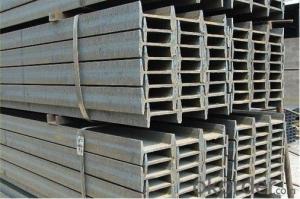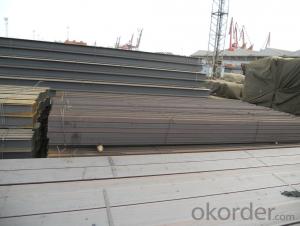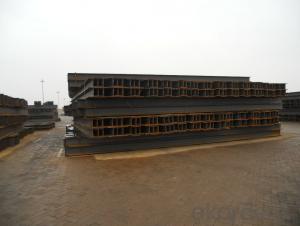Steel H Beam Hot Rolled High Quality 100-900MM
- Loading Port:
- China main port
- Payment Terms:
- TT OR LC
- Min Order Qty:
- 50 m.t.
- Supply Capability:
- 10000 m.t./month
OKorder Service Pledge
OKorder Financial Service
You Might Also Like
Item specifice
Steel H Beam Hot Rolled High Quality 100MM-900MM
Product Applications:
H Beam Hot Rolled High Quality 100MM-900MM are ideal for structural applications and are widely used in the construction of buildings and bridges, and the manufacturing, petrochemical, and transportation industries.
Product Advantages:
OKorder's H Beam Hot Rolled High Quality 100MM-900MM are durable, strong, and resist corrosion.
Main Product Features:
· Premium quality
· Prompt delivery & seaworthy packing (30 days after receiving deposit)
· Corrosion resistance
· Can be recycled and reused
· Mill test certification
· Professional Service
· Competitive pricing
Product Specifications:
Manufacture: Hot rolled
Grade: Q195 – 235
Certificates: ISO, SGS, BV, CIQ
Length: 6m – 12m, as per customer request
Packaging: Export packing, nude packing, bundled
Chinese Standard (H*W*T) | Weight (Kg/m) | 6m (pcs/ton) | Light I (H*W*T) | Weight (Kg/m) | 6m (pcs/ton) | Light II (H*W*T) | Weight (Kg/m) | 6M |
100*68*4.5 | 11.261 | 14.8 | 100*66*4.3 | 10.13 | 16.4 | 100*64*4 | 8.45 | 19.7 |
120*74*5.0 | 13.987 | 11.9 | 120*72*4.8 | 12.59 | 13.2 | 120*70*4.5 | 10.49 | 15.8 |
140*80*5.5 | 16.89 | 9.8 | 140*78*5.3 | 15.2 | 10.9 | 140*76*5 | 12.67 | 13.1 |
160*88*6 | 20.513 | 8.1 | 160*86*5.8 | 18.46 | 9 | 160*84*5.5 | 15.38 | 10.8 |
180*94*6.5 | 24.143 | 6.9 | 180*92*6.3 | 21.73 | 7.6 | 180*90*6 | 18.11 | 9.2 |
200*100*7 | 27.929 | 5.9 | 200*98*6.8 | 25.14 | 6.6 | 200*96*6.5 | 20.95 | 7.9 |
220*110*7.5 | 33.07 | 5 | 220*108*7.3 | 29.76 | 5.6 | 220*106*7 | 24.8 | 6.7 |
250*116*8 | 38.105 | 4.3 | 250*114*7.8 | 34.29 | 4.8 | 250*112*7.5 | 28.58 | 5.8 |
280*122*8.5 | 43.492 | 3.8 | 280*120*8.2 | 39.14 | 4.2 | 280*120*8 | 36.97 | 4.5 |
300*126*9 | 48.084 | 3.4 | 300*124*9.2 | 43.28 | 3.8 | 300*124*8.5 | 40.87 | 4 |
320*130*9.5 | 52.717 | 3.1 | 320*127*9.2 | 48.5 | 3.4 | |||
360*136*10 | 60.037 | 2.7 | 360*132*9.5 | 55.23 | 3 |

- Q:What are the design considerations for steel H-beams in multi-story buildings?
- Design considerations for steel H-beams in multi-story buildings include the following: 1. Load capacity: Steel H-beams need to be able to support the weight of the building, including the dead load (weight of the structure itself) and the live load (weight of occupants, furniture, and equipment). The beams must be designed to withstand these loads without excessive deflection or failure. 2. Span length: The span length of the beams is an important consideration in determining their size and spacing. Longer spans require larger and stronger beams to ensure structural integrity. 3. Structural stability: Steel H-beams must be designed to resist lateral loads such as wind and seismic forces. Additional bracing, such as diagonal members or cross-bracing, may be required to enhance the stability of the building. 4. Fire resistance: Multi-story buildings are subject to fire hazards, so the design of steel H-beams needs to incorporate fire protection measures. This can include the application of fire-resistant coatings or the use of fireproofing materials to ensure the integrity of the beams during a fire. 5. Architectural considerations: The design of H-beams should also consider the architectural requirements of the building. This may include the need for concealed beams, the integration of beams into architectural features, or the use of exposed beams as an aesthetic element. 6. Construction feasibility: The design of steel H-beams should take into account the ease of construction. This includes considerations such as the availability of standard beam sizes, connection details, and the feasibility of transporting and installing the beams on site. 7. Sustainability: The use of steel H-beams in multi-story buildings should also consider sustainability aspects. This can include the use of recycled steel, energy-efficient fabrication processes, and the ability to recycle or reuse the beams at the end of their lifespan. Overall, the design of steel H-beams in multi-story buildings requires a comprehensive understanding of structural engineering principles, architectural requirements, and construction feasibility to ensure a safe, stable, and aesthetically pleasing building.
- Q:Can steel H-beams be used in marine environments?
- Yes, steel H-beams can be used in marine environments, but they require proper protection and maintenance to prevent corrosion. Marine environments are known for their high levels of moisture, saltwater exposure, and harsh weather conditions, all of which can accelerate the corrosion process of steel. To mitigate these risks, steel H-beams used in marine environments should be made from corrosion-resistant materials, such as stainless steel or galvanized steel. Stainless steel is especially suitable for marine environments due to its high resistance to corrosion and rust. It contains a significant amount of chromium, which forms a thin, passive layer on the surface of the steel, protecting it from the corrosive effects of saltwater and moisture. Stainless steel H-beams can withstand the harsh marine environment without significant degradation, making them a popular choice for applications such as piers, bridges, and offshore structures. Galvanized steel is another viable option for marine environments. It is carbon steel that has been coated with a layer of zinc, which acts as a sacrificial barrier against corrosion. The zinc coating corrodes first, protecting the underlying steel from direct exposure to saltwater and moisture. However, galvanized steel may not be as durable as stainless steel in highly corrosive marine environments, and the protective zinc coating can wear off over time, requiring periodic maintenance and reapplication of the coating. Regardless of the type of steel used, regular maintenance and inspections are crucial to ensure the integrity of H-beams in marine environments. This includes regular cleaning to remove salt deposits, repainting or re-galvanizing as needed, and addressing any signs of corrosion or damage promptly. Additionally, proper design considerations should be made to account for the specific challenges posed by marine environments, such as tidal forces, wave impact, and temperature fluctuations. In summary, steel H-beams can be used in marine environments, provided they are made from corrosion-resistant materials like stainless steel or galvanized steel and are properly maintained. With the right precautions, these beams can withstand the harsh conditions of marine environments, making them a reliable choice for various marine structures and applications.
- Q:Can steel H-beams be used for supporting elevated walkways or platforms?
- Yes, steel H-beams can be used for supporting elevated walkways or platforms. Steel H-beams are commonly used in construction for their strength and durability. They provide excellent load-bearing capabilities, making them suitable for supporting structures like walkways and platforms. The H-shape design of these beams allows for greater weight distribution and resistance to bending or twisting forces, ensuring stability and safety for elevated structures. Additionally, steel H-beams can be easily fabricated and installed, making them a practical choice for such applications.
- Q:Can steel H-beams be used in the construction of transportation hubs or terminals?
- Yes, steel H-beams can be used in the construction of transportation hubs or terminals. Steel H-beams are commonly used in structural applications due to their strength, durability, and ability to support heavy loads. In transportation hubs or terminals, where large open spaces and long spans are often required, steel H-beams provide a reliable and cost-effective solution for creating strong and stable structures.
- Q:Can steel H-beams be used in exhibition halls or convention centers?
- Indeed, exhibition halls or convention centers can utilize steel H-beams. These beams are frequently employed in construction owing to their robustness and longevity. They furnish structural reinforcement and possess the capacity to endure substantial burdens, rendering them appropriate for capacious and unobstructed environments such as exhibition halls or convention centers. Moreover, steel H-beams can be readily manufactured and tailored to satisfy the precise design prerequisites of these establishments.
- Q:What are the different types of connections used for steel H-beams to timber?
- To join steel H-beams and timber, there are several types of connections available. These connections are commonly employed in construction projects that involve the integration of steel and timber components. 1. Bolting: Connecting steel H-beams to timber can be achieved through the widely used method of bolting. This method entails drilling holes in both the steel beam and timber and fastening them together using bolts. This connection method ensures a robust and rigid joint. 2. Welding: Another approach to connect steel H-beams and timber is by welding. This technique involves melting the surfaces of the steel beam and timber together, allowing them to cool and solidify. Welding creates a connection of high strength, but it necessitates specialized equipment and expertise. 3. Steel plates: Steel plates can be utilized as a means to connect steel H-beams and timber. This method involves attaching steel plates to the ends of the beams and then connecting them to the timber using bolts or other fasteners. The utilization of steel plates ensures a durable and dependable connection. 4. Timber connectors: Specific timber connectors are available for connecting steel H-beams and timber. These connectors are specially designed to establish a secure and stable joint between the two materials. Examples of timber connectors include angle brackets, gusset plates, and timber connectors with pre-drilled holes for bolts. 5. Adhesive bonding: In certain cases, adhesive bonding can be employed to connect steel H-beams and timber. This technique involves the application of a strong adhesive between the surfaces of the steel beam and timber, allowing it to cure. Adhesive bonding can establish a strong and long-lasting connection, although its suitability may vary depending on the specific application. It is crucial to consider various factors, such as structural requirements, load-bearing capacity, and project design, when selecting a connection method. Consulting with a structural engineer or a professional in the field is essential to determine the most suitable connection method for steel H-beams and timber in a given construction project.
- Q:What are the different types of steel H-beam connections for structures with high seismic activity?
- In structures with high seismic activity, it is crucial to ensure that the connections between steel H-beams are strong and capable of withstanding the dynamic forces generated during an earthquake. There are several types of steel H-beam connections that are commonly used in such structures to provide the required strength and stability. These include: 1. Welded Connection: Welding is a popular method for connecting steel H-beams in seismic structures. It involves fusing the ends of the beams together using heat and pressure. Welded connections are known for their high strength and rigidity, making them suitable for withstanding seismic forces. However, proper welding techniques and inspections are essential to ensure the integrity of the connection. 2. Bolted Connection: Bolted connections involve using bolts and nuts to join the steel H-beams. This method allows for easy assembly and disassembly, making it ideal for structures that may require future modifications. To enhance the seismic performance of bolted connections, high-strength bolts and appropriate washers are used. The bolts are tightened to specific torque requirements to ensure proper clamping force. Regular inspection and maintenance are necessary to prevent loosening of the bolts over time. 3. Moment-Resisting Connection: This type of connection is specifically designed to resist the rotational forces (moments) generated during an earthquake. Moment-resisting connections can be achieved using various techniques, such as welding, bolted flange plate connections, or end-plate connections. These connections provide enhanced stiffness and strength, allowing the structure to distribute seismic forces more effectively. 4. Shear Plate Connection: Shear plate connections involve using steel plates to connect the H-beams. These plates are typically welded to the flanges of the H-beams. Shear plate connections provide excellent resistance against lateral forces and can be designed to accommodate both shear and moment forces. They are commonly used in seismic structures due to their good energy dissipation capabilities. 5. Composite Connection: In composite connections, steel H-beams are connected to other structural elements, such as concrete slabs or columns. Composite connections utilize the combined strength and stiffness of the steel and concrete to enhance seismic resistance. These connections can be achieved through various methods, including welding, bolting, or using connectors specifically designed for composite structures. It is important to note that the selection of the appropriate steel H-beam connection for structures with high seismic activity should be based on careful analysis and engineering considerations. Factors such as the magnitude of seismic forces, structural design requirements, and local building codes should be taken into account to ensure the safety and performance of the overall structure.
- Q:How do steel H-beams contribute to the overall cost-effectiveness of a project?
- Steel H-beams contribute to the overall cost-effectiveness of a project in several ways. Firstly, they are an incredibly strong and durable material, which means that they require minimal maintenance and have a long lifespan. This reduces the need for frequent repairs or replacements, resulting in cost savings over time. Additionally, steel H-beams are lightweight compared to other construction materials, such as concrete or timber, making them easier and cheaper to transport and handle on-site. This can lead to reduced labor costs and shorter construction times, ultimately saving money in the overall project budget. Moreover, steel H-beams can be prefabricated off-site, which allows for greater precision and efficiency in the construction process. This reduces the risk of errors and wastage, leading to cost savings in terms of materials and labor. Furthermore, steel is a sustainable and environmentally friendly material. It is 100% recyclable, meaning that at the end of its lifespan, it can be repurposed or recycled, reducing waste and minimizing the environmental impact of the project. This aligns with the growing demand for sustainable construction practices and can potentially result in cost savings through incentives or tax benefits. Overall, the utilization of steel H-beams in a construction project offers numerous cost-effective advantages. Their strength, durability, and low maintenance requirements ensure long-term cost savings, while their lightweight nature and prefabrication capabilities reduce transportation and labor costs. Additionally, the sustainability of steel contributes to potential financial benefits.
- Q:Can steel H-beams be used in the construction of data centers or IT facilities?
- Yes, steel H-beams can be used in the construction of data centers or IT facilities. Steel H-beams are commonly used in structural applications due to their strength, durability, and load-bearing capabilities. In the construction of data centers or IT facilities, where the primary focus is on housing and protecting sensitive computer equipment, steel H-beams provide a solid framework for the building's structure. Data centers and IT facilities require a robust infrastructure to support the weight of heavy equipment, such as servers, switches, and storage systems. Steel H-beams possess high tensile strength and can withstand heavy loads, making them ideal for creating a stable and secure environment for sensitive IT infrastructure. Additionally, steel H-beams offer versatility in design and construction. They can be easily fabricated and connected to create customized support systems for various components within the data center. This allows for flexible layouts and efficient use of space, which is essential in data center construction. Moreover, steel H-beams have excellent fire-resistant properties, providing an added layer of safety for a data center or IT facility. The inherent fire resistance of steel helps to protect the valuable equipment housed within the facility, minimizing the risk of damage or loss in the event of a fire. Overall, steel H-beams are a popular choice for the construction of data centers and IT facilities due to their strength, durability, load-bearing capabilities, versatility, and fire-resistant properties. Their use ensures the creation of a secure and well-supported environment for the critical IT infrastructure housed within these facilities.
- Q:Are steel H-beams suitable for use in the construction of recreational facilities or parks?
- Yes, steel H-beams are appropriate for the construction of recreational facilities or parks. Steel H-beams are renowned for their strength, durability, and versatility, which makes them perfect for supporting different structures in recreational facilities and parks. These beams have a high load-bearing capacity, making them suitable for building bridges, pavilions, walkways, and other infrastructure within recreational areas. Steel H-beams offer several advantages compared to other construction materials. Firstly, they provide outstanding structural integrity, ensuring stability and safety for the facilities. Their ability to withstand heavy loads, such as equipment, vehicles, or large crowds, makes them highly reliable for long-term use. Additionally, steel H-beams are resistant to corrosion, weathering, and pests, making them low-maintenance and ideal for outdoor environments. Another advantage of steel H-beams is their flexibility in design. These beams can be manufactured in different sizes and shapes, enabling architects and engineers to create unique and innovative structures that enhance the aesthetics and functionality of recreational facilities or parks. Moreover, they can be easily modified or expanded if necessary, providing adaptability for future changes or additions to the facility. Furthermore, steel H-beams are environmentally friendly. Steel is a recyclable material, and using steel H-beams in park construction promotes sustainability and reduces the environmental impact. Additionally, steel structures have a long lifespan, reducing the need for frequent replacements and minimizing waste generation. In conclusion, steel H-beams are highly appropriate for use in the construction of recreational facilities or parks. Their strength, durability, versatility, and sustainability make them an excellent choice for supporting various structures within these areas.
1. Manufacturer Overview |
|
|---|---|
| Location | |
| Year Established | |
| Annual Output Value | |
| Main Markets | |
| Company Certifications | |
2. Manufacturer Certificates |
|
|---|---|
| a) Certification Name | |
| Range | |
| Reference | |
| Validity Period | |
3. Manufacturer Capability |
|
|---|---|
| a)Trade Capacity | |
| Nearest Port | |
| Export Percentage | |
| No.of Employees in Trade Department | |
| Language Spoken: | |
| b)Factory Information | |
| Factory Size: | |
| No. of Production Lines | |
| Contract Manufacturing | |
| Product Price Range | |
Send your message to us
Steel H Beam Hot Rolled High Quality 100-900MM
- Loading Port:
- China main port
- Payment Terms:
- TT OR LC
- Min Order Qty:
- 50 m.t.
- Supply Capability:
- 10000 m.t./month
OKorder Service Pledge
OKorder Financial Service
Similar products
New products
Hot products
Related keywords

























